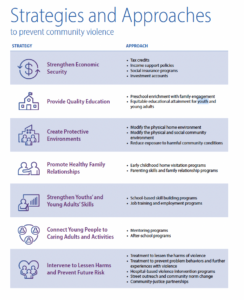CDC Releases Community Violence Prevention Resource for Action
The Centers for Disease Control and Prevention (CDC) has released the latest Resource for Action on community violence prevention. The Community Violence Prevention Resource for Action is an update to the Youth Violence Prevention Resource for Action and compiles the best available evidence to prevent violence among youth and young adults, focusing on community violence that occurs in public spaces, like streets and parks, between people who may or may not be acquainted. It provides evidence-based strategies and approaches to enhance community safety and health, including:
- Strengthening economic security.
- Providing quality education.
- Creating protective environments.
- Promoting healthy family relationships.
- Strengthening skills in youth and young adults.
- Connecting young people to caring adults.
- Intervening to lessen harms and prevent future risks.
The Community Violence Prevention Resource for Action shares several overlapping strategies included in the Intimate Partner Violence (IPV) Prevention Resource for Action and the Sexual Violence (SV) Prevention Technical Package:
1. Focus on Economic Supports:
All three documents emphasize the importance of strengthening economic supports to reduce violence. For instance, improving financial stability and reducing economic stress are seen as critical in mitigating risks associated with IPV, SV, and community violence. Policies such as tax credits, income supports, and microfinance programs are highlighted as effective ways to alleviate economic pressures that contribute to violence in homes and communities.
2. Creating Protective Environments:
The creation of protective environments is another common theme. For example, in the Community Violence Prevention Resource for Action, modifying physical environments, like greening spaces, and improving social cohesion in neighborhoods are discussed as strategies to reduce violence. Similarly, the IPV Prevention resource highlights improving school and workplace climates and reducing alcohol outlet density as ways to create safer environments, which also contribute to lowering risks of violence.
3. Promoting Healthy Relationships and Skill Building:
 All three resources emphasize the importance of teaching relationship skills, especially for youth. Social-emotional learning programs, healthy relationship education, and mentoring programs are promoted as strategies to prevent SV, IPV, and community violence by fostering healthy interpersonal dynamics early on in life.
All three resources emphasize the importance of teaching relationship skills, especially for youth. Social-emotional learning programs, healthy relationship education, and mentoring programs are promoted as strategies to prevent SV, IPV, and community violence by fostering healthy interpersonal dynamics early on in life.
4. Multi-Sectoral Approaches:
Each document underscores the importance of a multi-sectoral approach involving public health, education, business, and social services sectors. For example, engaging influential adults and peers, implementing workplace policies, and community-level interventions are discussed across the resources to address the various levels of the social ecology influencing violence.
5. Support for Survivors:
The resources also align in their emphasis on supporting survivors to reduce harms and prevent future violence. This includes access to victim-centered services, legal protections, housing programs, and therapeutic interventions. Ensuring that survivors have the resources and support they need is critical for reducing the recurrence of violence and promoting healing.
While each document targets different aspects of violence prevention, they collectively support comprehensive strategies that address the root causes of violence, involve multiple sectors, and emphasize the importance of addressing social determinants of health, such as economic inequality, racial and ethnic disparities, and systemic inequities, which contribute to the risk of violence. Multi-sector partnerships, community engagement, and tailored interventions can be adapted across different contexts to reduce community, intimate partner, and sexual violence.
